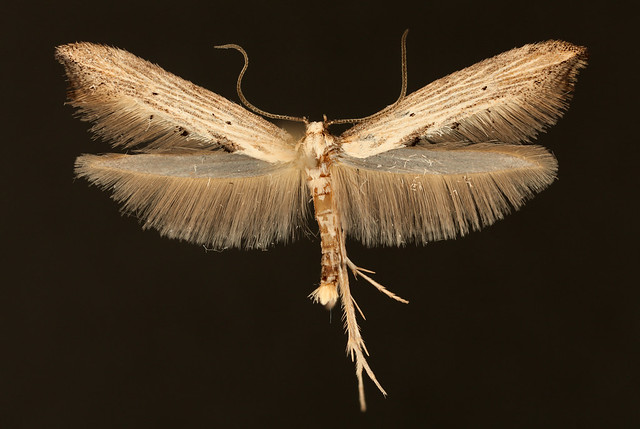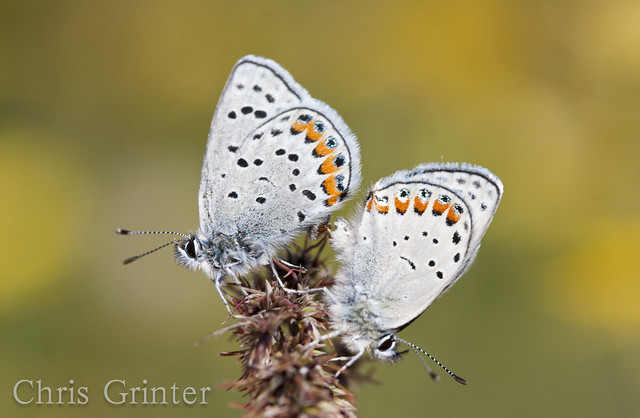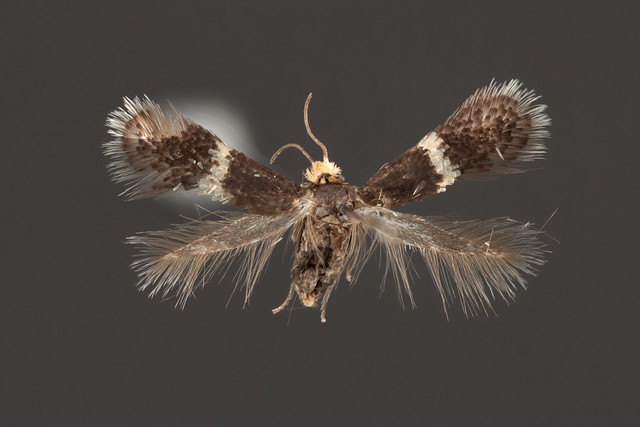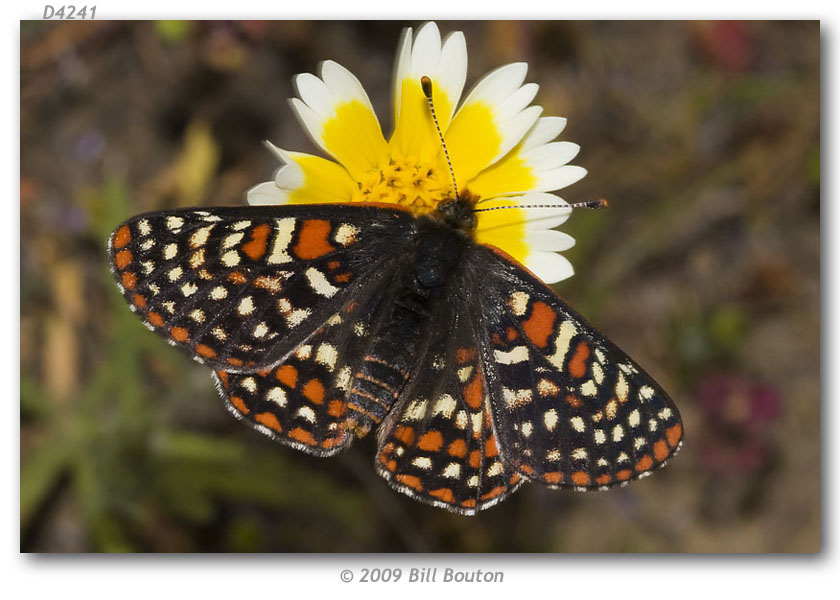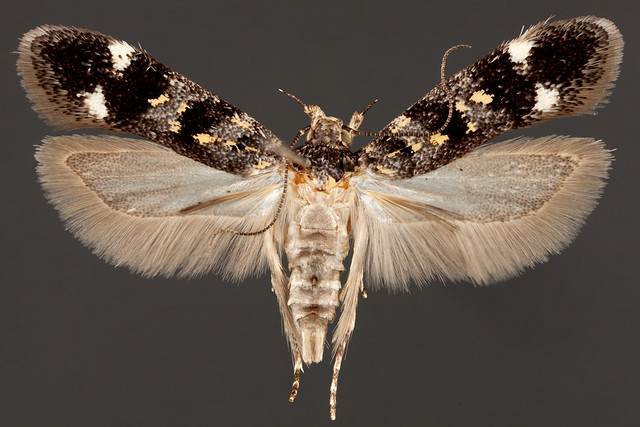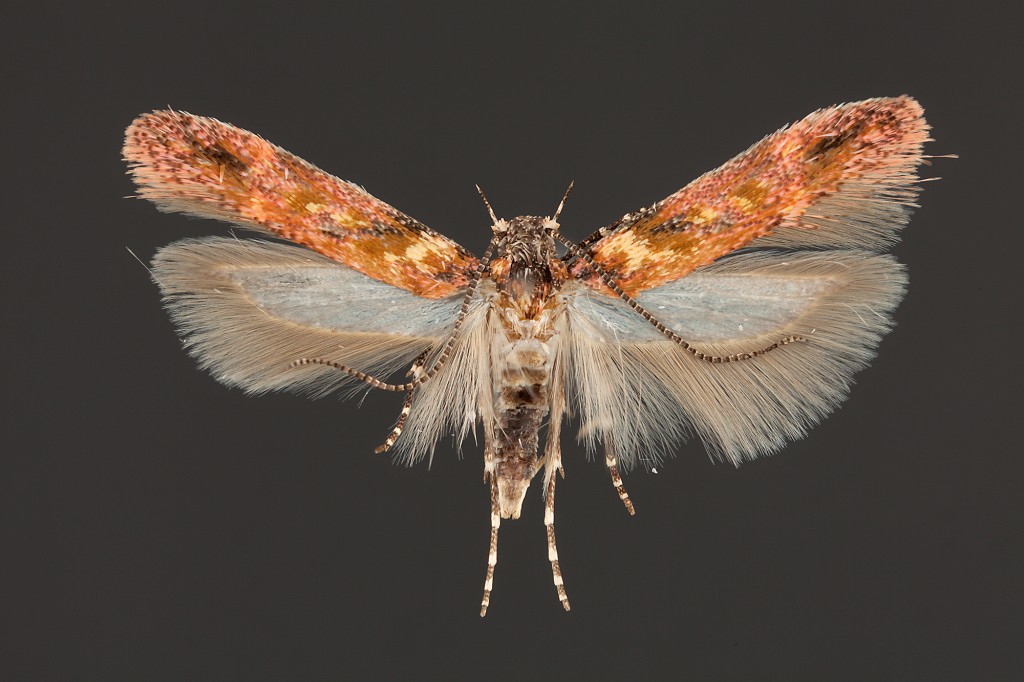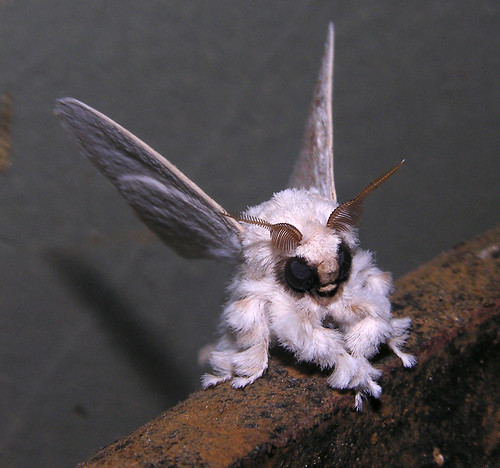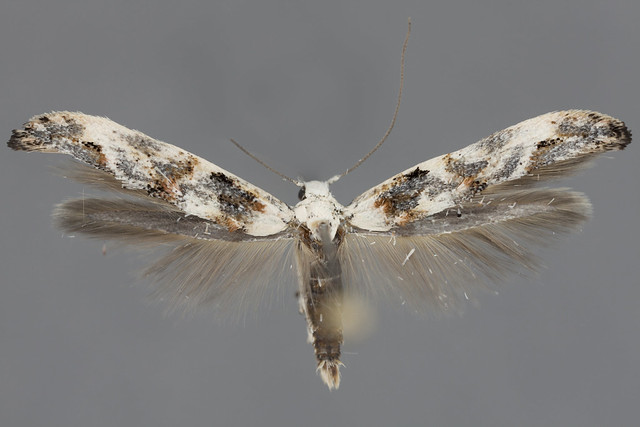Dnešné mora je krásne druhy z vonkajšej Skalnaté hory Denver, Epermenia stolidota (Epermeniidae). Jedná sa vlastne o väčšiu vzorku, ako sa zdá, o 20 mm od koncom krídla na koncoch krídel. Tých, ktoré boli, zatemnený, trsy váhy na zadnej hrane predného krídla je veľký znak pre túto rodinu, ako aj tuhými štetinami na zadnej holennej (tiež trochu vidieť tu). Existuje 11 druhy v 2 rody v Spojených štátoch, sa pravdepodobne niekoľko ďalších, aby sa objavil. Fellow kurátorský asistent David Bettman zadal tento druh s použitím revíziu nearktické druhov: Tu PDF.
|
Tento týždeň som zdieľania malý, ošumělý, and semi-competently spread Nepticulidae in the genus Stigmella from the same light trap of Prescott Arizona as the past few Monday Moths. Obvykle by zdieľať fotografie mora, ktorá nie je v najlepšej kondícii, but I’m using this as an example of technique. Not only was this 4mm moth pulled out of the bottom of a light trap, but it was field pinned and dried for over a year and a half. I’ve always heard that it can nearly be impossible to deal with the smallest of the small; and for the most part I haven’t. I used to think you need to capture them off of a light sheet alive in a vial and euthanize moments before spreading, all while never, ever let them dry the tiniest bit beforehand. But as it turns out, you can get away with a decent specimen by relaxing 24 hours and spreading upside down. Of course if you have a perfectly fresh specimen that avoided the blender of a bucket-trap it would make for a far superior specimen. Ešte lepšie, you pulled the leaf mine and reared the moth yourself. Most of these Nepticulidae are host-specific and far more diverse than we have given them credit. I’ve heard there could be at least 100 new species awaiting discovery in the US alone. The story of many San Francisco butterflies are well known and depressing. The area has been heavily impacted by human development for over two centuries and is the infamous home to the first known example of an extinct American butterfly, the Xerces blue. While other butterflies are hanging on, or getting help to hang on like the Mission modrá, some like the Bay Checkerspot have continued to decline despite valiant efforts for reintroduction. Today, the only known colony of the Bay Checkerspot is within Santa Clara County on a site called Coyote Ridge. It was twenty one years of intensive study of the checkerspot in the 1960’s and 70’s by the famous biologist Paul Ehrlich that provided the impetus for federal listing in 1987. Ako 1998 the colonies he studied have since gone extinct. Here is an excerpt from a 1980 paper in the Journal of the Lepidopterists’ Spoločnosť “Two California Checkerspot Butterfly Species, One New, One on the Verge of Extinction” (.pdf).
All efforts to relocate this butterfly have failed, and the future of this animal is not looking bright. And so what exactly is this creatures name? In 1937 Robert F. Sternitzky described what he thought to be an overlooked San Francisco butterfly “Euphydryas editha var. bayensis“. Those early descriptions of variations and races are roughly equivalent to today’s subspecies – and so the butterfly remained bayensis for decades and became a mascot for conservation. But where was the very first Euphydras editha from and how did the San Francisco bayensis differ? Unfortunately the original description is vague and the collecting locality is simply listed as “Kalifornia”, as was the unfortunate habit of Boisduval who described the butterfly 1852. But all hope is not lost since the famous French Lepidopterist was having specimens sent to him by the earliest California Lepidopterist, Pierre Joseph Michel Lorquin. An eager gold prospector and butterfly collector, Lorquin traveled California from 1849 na 1858 and again in 1869. Every butterfly that was sent back to France was a new species and subsequently described by Boisduval – who of course named one of California’s most beautiful butterflies after Lorquin. Enter Emmel, Emmel and Mattoon in 1994 who were writing the Systematics of Western North American Butterflies. In the process of cleaning up the mess of these early western species they had to designate a Lectotype for E. editha editha since Boisduval never fixed a Holotype in 1852. Essentially he named a new species without designating the taxonomic standard for the group, making future work ambiguous for taxonomists. Thankfully the travels of Lorquin have roughly been documented and we can ascertain that he should have been in San Francisco around 1849. Comparisons of the original specimens to the Bay Checkerspot made for an overwhelming case that it was this butterfly that was sent to France in the 19th century. The result of this finding therefore places the Bay Checkerspot Euphydryas editha bayensis into synonymy with the older name Euphydryas editha editha. The name bayensis effectively dissappeared because it was a re-description of a butterfly that was already known. Euphydryas e. editha as it turns out has been known from coastal California from the bay region down to San Luis Obispo – and so voila, the range of the Bay Checkerspot just exploded. But of course the story isn’t that simple and the butterfly didn’t become magically safe with a name change. Conservation groups and ecologist kicked and screamed and refused to accept the change, even the Xerces Society hasn’t jumped on board with the consensus of taxonomists out of what I can only assume is fear of the appearance that their butterfly is no longer endangered. I’ll emphasize that this doesn’t mean that the populations in the bay are no longer threatened – there is still a need for protecting these biologically significant populations as they are significantly declining. Habitats all throughout the region are facing ongoing and pernicious threats (pdf). All in all the name change is trivial, we can now call the Edith’s Checkerspot the Bay Checkerspot, and still fight to protect this butterfly. I’m unsure of what would be required to amend the federal register, and if it’s at all possible to expand protection of an animal like this without re-petitioning the endangered species act. So perhaps I can understand the failure to embrace the name change since from the outside it looks like their bug is no longer endangered. Naproti tomu, this could bring attention to populations of a butterfly that have been overlooked for decades.
Many thanks to John Pelham for conferring with me over this taxonomic headache.
Čo tak ďalší neidentifikovaný Gelechiidae z rovnakého miesta ako predchádzajúci exemplár (č. Prescott Arizona). Robím bodnutie do tejto mory, ktorá je v rode Chionody – a je povrchne podobný druhu C. ďalej. Našťastie existuje monografia o tejto skupine (Mole Ameriky severne od Mexika, zväzok 7.6) a budem schopný pitvať a dúfam, že dôjdem k lepšej identifikácii. Genitálie mole sú nádherne sklerotizované štruktúry, ktoré môžu poskytnúť množstvo znakov používaných na identifikáciu. Budem musieť určite čoskoro zdieľať obrázky toho, ako vyzerajú genitálie!
Tento motýľ je dobrým príkladom toho, čo veľa mojich mesiacov sú v súčasnosti – neidentifikovaný! To je určite Gelechiidae, môžete vidieť veľké obrátené palps na prednej časti hlavy, a prst v tvare projekcie na špičkách zadných krídlach. Len o jeden z najjednoduchších rodiny microleps k identifikácii. A z obyčajného gestalt snáď je to v Gnorimoschemini? Ak niekto spozná svojho drobčeka, dajte mi prosím vedieť, inak budem útočiť na literatúru, aby sa pokúsila vypátrať meno. Tento krásny motýľ je z hôr mimo regiónu Prescott, AZ – Júl 2010. Skôr príjemne, existuje toľko microlepidoptera, ktoré nie sú ľahko identifikovať. Možno ste už počuli šokujúcu správu o pripravované zmeny v poľnom prírodovednom múzeu v Chicagu. Stručne povedané, Múzeum je vo finančnej kríze a masívne zmeny bude realizovaný nového prezidenta, Richard Lariviere. Je pravdepodobné, že až polovica výskumníkov (vrátane zamestnaných kurátorov) budú prepustené a všetky výskumné oddelenia budú rozpustené do “veda a vzdelávanie”. Peniaze sa vynaložia na modernizáciu exponátov, to všetko pri vyprázdňovaní vedeckého jadra múzea. Nájdite si chvíľu na podpísanie tejto petície a vyjadrite svoje znepokojenie: Chráňte výskum v poľnom múzeuPred niekoľkými mesiacmi mnohí z vás pravdepodobne narazili na tento meme – slávny Pudel Moth! A skutočne, väčšinou boli správy napoly slušné. Áno, to je skutočné. Áno, je to nočný motýľ. Áno, je to pravdepodobne druh v Lasiocampidae (prípadne rod Artácia) ako správne poukázal Dr. John Rawlins. Čakal som, že to bude všetko dobré a dobré, hej, vonku je veľa roztomilých molí a je načase, aby si to niekto všimol! Neobťažoval som sa čítať článok, kým mi ho kolega nepreposlal z “Cosmic Prihláste sa na nbcnews.com“. Čo som našiel, bolo Žiadna skutočná škoda, ale celá tá vec s kryptozoológiou ma rozčuľuje. Myslím si, že je nešťastné, že kryptozoológ získal toľko publicity a hovorilo sa o ňom s dostatočnou dávkou dôveryhodnosti. Kryptozoológia je nie veda, ani nikdy nebude. Keď sa kryptozoológia vykonáva ako veda, nazýva sa to biológia. Áno, sú tam blázni, ktorí veria, že vedú skutočnú vedu, sledovať príbehy v kruhoch a stavať hromady anekdot “dôkazy” ktoré, zdá sa, nikdy nevedú k pravdám. Existujú skutočné rozdiely medzi tým, čo robí vedec a pseudovedec. Povedzme, že vedec počuje správy o zvláštnom zvierati žijúcom v hlbokej džungli – vydávajú sa na expedíciu (po žobraní o financie) robiť tvrdú prácu pri spájaní miestnych príbehov a putovaní po džungli alebo potápaní v oceánoch, aby ste našli exempláre. Potom prinesú tieto exempláre domov, rozobrať každý detail, a publikovať výsledky v recenzovanom časopise. Ak sa nenašli žiadne exempláre, potom sa vedec vráti domov s prázdnymi rukami a prehodnotí možnosť tohto nového mýtického tvora. Možno by im viac financií dalo viac času v teréne… (vždy odpoveď, právo?) Ale tam sa príbeh končí, bez dôkazov zviera neexistuje. Tu sa kryptozoológia odchyľuje od skutočnej vedy – anekdotické príbehy berú ako fakt a nikdy nepriznajú porážku. Nessy existuje, pretože ľudia viď ho. Vysvetlením nemôže byť žiadne veľké množstvo vierohodnejších možností… pretože svet, v ktorom kryptozoológ žije, je mýtický av zásade nie skutočný. OK dosť chválospevu, Dúfajme, že sa do spravodajského cyklu dostanú ďalšie rozkošné nočné motýle! Dnešné mora je ohromujúca mikro a iná bytosť z Barb Bartell v zadnom dvore v Skalnatých horách. Podľa mojich najlepších vedomostí je to druh Mompha (Coleophoridae), pravdepodobne claudiella,ale nemám pozitívny ID na túto chybu ešte. Keď sa začnem prehrabávať v mikroinformáciách z tejto stránky, určite ma čakajú prekvapenia! |
Skepticizmus |
